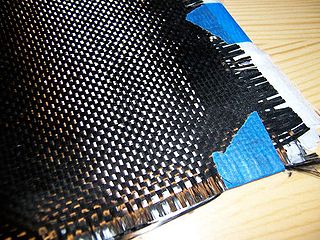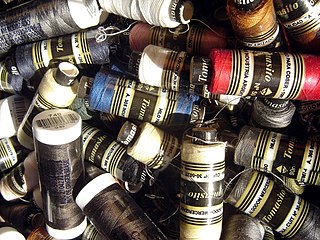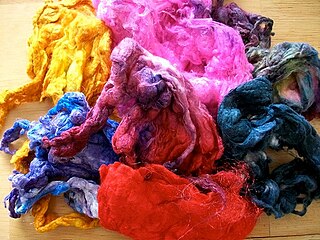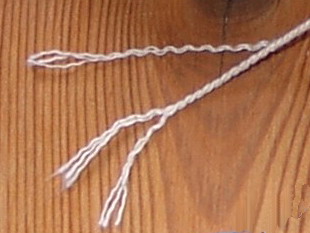 W
WFiber or fibre is a natural or man-made substance that is significantly longer than it is wide. Fibers are often used in the manufacture of other materials. The strongest engineering materials often incorporate fibers, for example carbon fiber and ultra-high-molecular-weight polyethylene.
 W
WAnimal fibers are natural fibers that consist largely of certain proteins. Examples include silk, hair/fur and feathers. The animal fibers used most commonly both in the manufacturing world as well as by the hand spinners are wool from domestic sheep and silk. Also very popular are alpaca fiber and mohair from Angora goats. Unusual fibers such as Angora wool from rabbits and Chiengora from dogs also exist, but are rarely used for mass production.
 W
WCarbon fibers or carbon fibres are fibers about 5 to 10 micrometers (0.00020–0.00039 in) in diameter and composed mostly of carbon atoms. Carbon fibers have several advantages including high stiffness, high tensile strength, low weight to strength ratio, high chemical resistance, high temperature tolerance and low thermal expansion. These properties have made carbon fiber very popular in aerospace, civil engineering, military, and motorsports, along with other competition sports. However, they are relatively expensive when compared with similar fibers, such as glass fiber, basalt fibers, or plastic fibers.
 W
WFiber crops are field crops grown for their fibers, which are traditionally used to make paper, cloth, or rope.
 W
WPolyethylene or polythene is the most common plastic in use today. It is a polymer, primarily used for packaging. As of 2017, over 100 million tonnes of polyethylene resins are being produced annually, accounting for 34% of the total plastics market.
 W
WCarding is a mechanical process that disentangles, cleans and intermixes fibres to produce a continuous web or sliver suitable for subsequent processing. This is achieved by passing the fibres between differentially moving surfaces covered with card clothing. It breaks up locks and unorganised clumps of fibre and then aligns the individual fibres to be parallel with each other. In preparing wool fibre for spinning, carding is the step that comes after teasing.
 W
WEisengarn, meaning "iron yarn" in English, is a light-reflecting, strong, waxed-cotton thread. It was invented and manufactured in Germany in the mid-19th century, but is now best known for its use in cloth woven for the tubular-steel chairs designed by Marcel Breuer while he was a teacher at the Bauhaus design school.
 W
WFibrils are structural biological materials found in nearly all living organisms. Not to be confused with fibers or filaments, fibrils tend to have diameters ranging from 10-100 nanometers. Fibrils are not usually found alone but rather are parts of greater hierarchical structures commonly found in biological systems. Due to the prevalence of fibrils in biological systems, their study is of great importance in the fields of microbiology, biomechanics, and materials science.
 W
WKnitting is a method by which yarn is manipulated to create a textile or fabric. It is used in many types of garments. Knitting may be done by hand or by machine.
 W
WLeaf fibers or hard fibers are a type of plant fiber mainly used for cordage. They are the toughest of the plant fibers which is most likely due to their increased lignin content when compared to the other groups of plant fibers. They are typically characterized as being very tough and rigid lending them towards being used in rope production over clothing or paper like other plant fibers.
 W
WLint is the common name for visible accumulations of textile fibers and other materials, usually found on and around clothing. Certain materials used in the manufacture of clothing, such as cotton, linen, and wool, contain numerous, very short fibers bundled together. During the course of normal wear, these fibers may either detach or be jostled out of the weave of which they are part. This is the reason that heavily used articles like shirts and towels become thin over time, and why these particles collect in the lint screen of a clothes dryer.
 W
WLotus silk is a type of textile produced using delicate lotus stem fibers. The fabric first originated in Myanmar (Burma), and is now also woven by smaller-scale cottage industries in Vietnam. Due to the complexity and labor-intensive nature of weaving lotus fibers, lotus silk is considered one of the most expensive fabrics in the world.
 W
WMercerisation is a textile finishing treatment for cellulose fabric and yarn, mainly cotton and flax, which improves dye uptake and tear strength, reduces fabric shrinkage, and imparts a silk-like luster.
 W
WMilk fiber or milk wool is a type of Azlon, a regenerated protein fiber based on the casein protein found in milk. There are several trade names for milk casein based fibers including Lanital, Fibrolane and Aralac.
 W
WNanofibers are fibers with diameters in the nanometer range. Nanofibers can be generated from different polymers and hence have different physical properties and application potentials. Examples of natural polymers include collagen, cellulose, silk fibroin, keratin, gelatin and polysaccharides such as chitosan and alginate. Examples of synthetic polymers include poly(lactic acid) (PLA), polycaprolactone (PCL), polyurethane (PU), poly(lactic-co-glycolic acid) (PLGA), poly(3-hydroxybutyrate-co-3-hydroxyvalerate) (PHBV), and poly(ethylene-co-vinylacetate) (PEVA). Polymer chains are connected via covalent bonds. The diameters of nanofibers depend on the type of polymer used and the method of production. All polymer nanofibers are unique for their large surface area-to-volume ratio, high porosity, appreciable mechanical strength, and flexibility in functionalization compared to their microfiber counterparts.
 W
WNatural fibers or natural fibres are fibers that are produced by geological processes, or from the bodies of plants or animals. They can be used as a component of composite materials, where the orientation of fibers impacts the properties. Natural fibers can also be matted into sheets to make paper or felt.
 W
WNoil is the short fiber left over from combing wool or spinning silk and used as a decorative additive for many spinning projects like rovings and yarns. Silk noil is also called "raw silk", although that is a misnomer. As noil is a relatively short fiber, fabric made from noil is weaker and considered less valuable.
 W
WPolyaniline nanofibers are a high aspect form of polyaniline, a polymer consisting of aniline monomers, which appears as discrete long threads with an average diameter between 30 nm and 100 nm. Polyaniline is one of the oldest known conducting polymers, being known for over 150 years. Polyaniline nanofibers are often studied for their potential to enhance the properties of polyaniline or have additional beneficial properties due to the addition of a nanostructure to the polymer. Properties that make polyaniline useful can be seen in the nanofiber form as well, such as facile synthesis, environmental stability, and simple acid/base doping/dedoping chemistry. These and other properties have led to the formation of various applications for polyaniline nanofibers as actuators, memory devices, and sensors.
 W
WA rolag is a roll of fibre generally used to spin woollen yarn. A rolag is created by first carding the fibre, using handcards, and then by gently rolling the fibre off the cards. If properly prepared, a rolag will be uniform in width, distributing the fibres evenly. The word derives from the Scottish Gaelic word for a small roll.
 W
WA roving is a long and narrow bundle of fiber. Rovings are produced during the process of making spun yarn from wool fleece, raw cotton, or other fibres. Their main use is as fibre prepared for spinning, but they may also be used for specialised kinds of knitting or other textile arts.
 W
WSambe, or hemp fiber, is a traditional fiber for Korean clothing. The knowledge of weaving sambe skillfully is being lost, has been deemed a national treasure, and specific individuals with the ability were designated intangible cultural assets. Sambe was the primary textile fiber used in clothing for commoners prior to the introduction of cotton to Korea in the late 15th century. A particularly fine variety is andongpo from Andong, North Gyeongsang Province.
 W
WSea silk is an extremely fine, rare, and valuable fabric that is made from the long silky filaments or byssus secreted by a gland in the foot of pen shells. The byssus is used by the clam to attach itself to the sea bed.
 W
WSetralit is a technical natural fiber based on plant fibers whose property profile has been modified selectively in order to meet different industrial requirements. It was first manufactured in 1989 by Jean-Léon Spehner, an Alsatian engineer, and further developed by the German company ECCO Gleittechnik GmbH. The name “Setralit“ is derived from the French company Setral S.à.r.l. which is a subsidiary company of ECCO, where Spehner was employed at that time. Setralit was officially described first in 1990.
 W
WStress fibers are contractile actin bundles found in non-muscle cells. They are composed of actin (microfilaments) and non-muscle myosin II (NMMII), and also contain various crosslinking proteins, such as α-actinin, to form a highly regulated actomyosin structure within non-muscle cells. Stress fibers have been shown to play an important role in cellular contractility, providing force for a number of functions such as cell adhesion, migration and morphogenesis.
 W
WString is a long flexible structure made from fibers twisted together into a single strand, or from multiple such strands which are in turn twisted together. String is used to tie, bind, or hang other objects. It is also used as a material to make things, such as textiles, and in arts and crafts. String is a simple tool, and its use by humans is known to have been developed tens of thousands of years ago. In Mesoamerica, for example, string was invented some 20,000 to 30,000 years ago, and was made by twisting plant fibers together. String may also be a component in other tools, and in devices as diverse as weapons, musical instruments, and toys.
 W
WIn the textile industry, a tow is a coarse, broken fibre, removed during processing flax, hemp, or jute and separated from the shives. Flax tows are often used as upholstery stuffing and oakum. Tows in general are frequently cut up to produce staple fibre. The very light color of flax tow is the source of the word "towhead", meaning a person with naturally light blonde hair.
 W
WTwine is a strong thread, light string or cord composed of two or more thinner strands twisted, and then twisted together (plied). The strands are plied in the opposite direction to that of their twist, which adds torsional strength to the cord and keeps it from unravelling. This process is sometimes called reverse wrap. The same technique used for making twine is also used to make thread, which is thinner, yarn, and rope, which is stronger and thicker, generally with three or more strands.
 W
WVulcanized fibre or red fibre is a laminated plastic composed of only cellulose. The material is a tough, resilient, hornlike material that is lighter than aluminium, tougher than leather, and stiffer than most thermoplastics. The newer wood-laminating grade of vulcanized fibre is used to strengthen wood laminations used in skis, skateboards, support beams and as a sub-laminate under thin wood veneers.
 W
WWalis (Walissima) is a natural plant fiber obtained from the plant Sida rhombifolia, of the Malvaceae family. It is produced mainly in the Philippine islands.
 W
WWood wool, known primarily as excelsior in North America, is a product made of wood slivers cut from logs. It is mainly used in packaging, for cooling pads in home evaporative cooling systems known as swamp coolers, for erosion control mats, and as a raw material for the production of other products such as bonded wood wool boards. In the past it was used as stuffing, or padding, in upholstry, or to fill stuffed toys. It is also sometimes used by taxidermists to construct the armatures of taxidermy mounts.
 W
WZari is an even thread traditionally made of fine gold or silver used in traditional Indian, Bangladeshi and Pakistani garments, especially as brocade in saris etc. This thread is woven into fabrics, primarily of silk, to make intricate patterns and elaborate designs of embroidery called zardozi. Zari was popularised during the Moghul era, the port of Surat was linked to the Meccan pilgrimage route which served as a major factor for re-introducing this ancient craft in India. During the Vedic ages, the gold embroidery was associated with the grandeur and regal attire of gods, kings, and literary figures (gurus){as shown in the movies}.